American Views of Immigration and Diversity

While half of Americans and a majority of Democrats say diversity makes the United States a better place to live, Republicans aren’t so sure.
Key Findings
-
A majority of Americans (53%)—including majorities of Democrats (71%) and Independents (53%)—say that the increasing racial and ethnic diversity of the United States makes the country a better place to live.
-
Republicans are divided on the question. A plurality (37%) say it makes no difference, while roughly a third each say it makes the country better (33%) or worse (29%).
-
Most Republicans (70%)—but few Democrats (18%)—say that large numbers of immigrants and refugees coming into the country represent a critical threat to the United States.
-
Pluralities of Americans overall (43%), Democrats (45%), and Independents (42%) favor keeping legal immigration levels at their present level. But Republicans would prefer to decrease legal immigration levels (46%).
-
In both parties, immigration attitudes are linked to underlying views of the effects of America’s growing diversity on the United States. But the view that increased diversity makes the country a worse place to live is a minority viewpoint among every political and ideological subgroup.
Partisanship and Immigration
Republican political leaders have invoked the language of national security when referring to immigration, calling the situation on the southern border an “invasion.” Once a term that was confined to the fringes of Republican circles, the word invasion featured prominently in midterm campaign ads for GOP candidates in Florida, Georgia, and Arizona. Former President Donald Trump certainly played a role in bringing this type of anti-immigrant rhetoric into the political mainstream. Still, some analysts argue that he simply met the Republican base where they’ve always been on immigration issues, and that previous Republican leaders who took a softer stance on immigration were, in fact, out of touch.
The growing divide between Republicans and Democrats on the issue of immigration is being caused predominantly by movement among Democrats, who have become far more pro-immigration over the last 30 years. The 1996 Democratic Party platform touted President Bill Clinton’s efforts to solve the problem of “criminal immigrants, deported after committing crimes in America, return[ing] the very next day to commit crimes again.” Two of the laws that form the foundation of the modern immigration enforcement system, essentially by expanding the grounds for detaining and deporting immigrants, were also passed under the Clinton administration. By contrast, the Democratic Party’s present immigration policy classifies detention of immigrants as a “last resort” and seeks to expand the asylum system and pathways to citizenship—a near 180-degree turn from 30 years ago.
This evolution extends to the public level, where attitudes around immigration have also been driven primarily by changes in how Democrats view the issue. Over the past two decades, Democrats have become increasingly likely to favor increased levels of legal immigration and less likely to view large-scale migration to the US as a critical threat to the country. These differing concerns around immigration also reflect differing views of the impact that the growing diversity of the country has on the United States. Additionally, while Republicans and Democrats disagree on immigration issues, both parties are also split internally—though on different aspects of immigration.
Half of Americans say Growing Diversity Makes US a Better Place to Live
A majority of Americans (53%) say the increasing number of people of many different races, nationalities, and ethnic groups in the United States makes the country a better place to live in. A third (31%) say it makes no difference, and 15 percent say it makes the country a worse place to live.
Republicans and Democrats hold strikingly different views about the growing diversity of the country. While a large majority of Democrats (71%) see it as making the country better, Republicans are far more divided. A narrow plurality of Republicans say it makes no difference (37%), while a third say it makes the country better (33%) and three in 10 say it makes the country a worse place to live (29%).
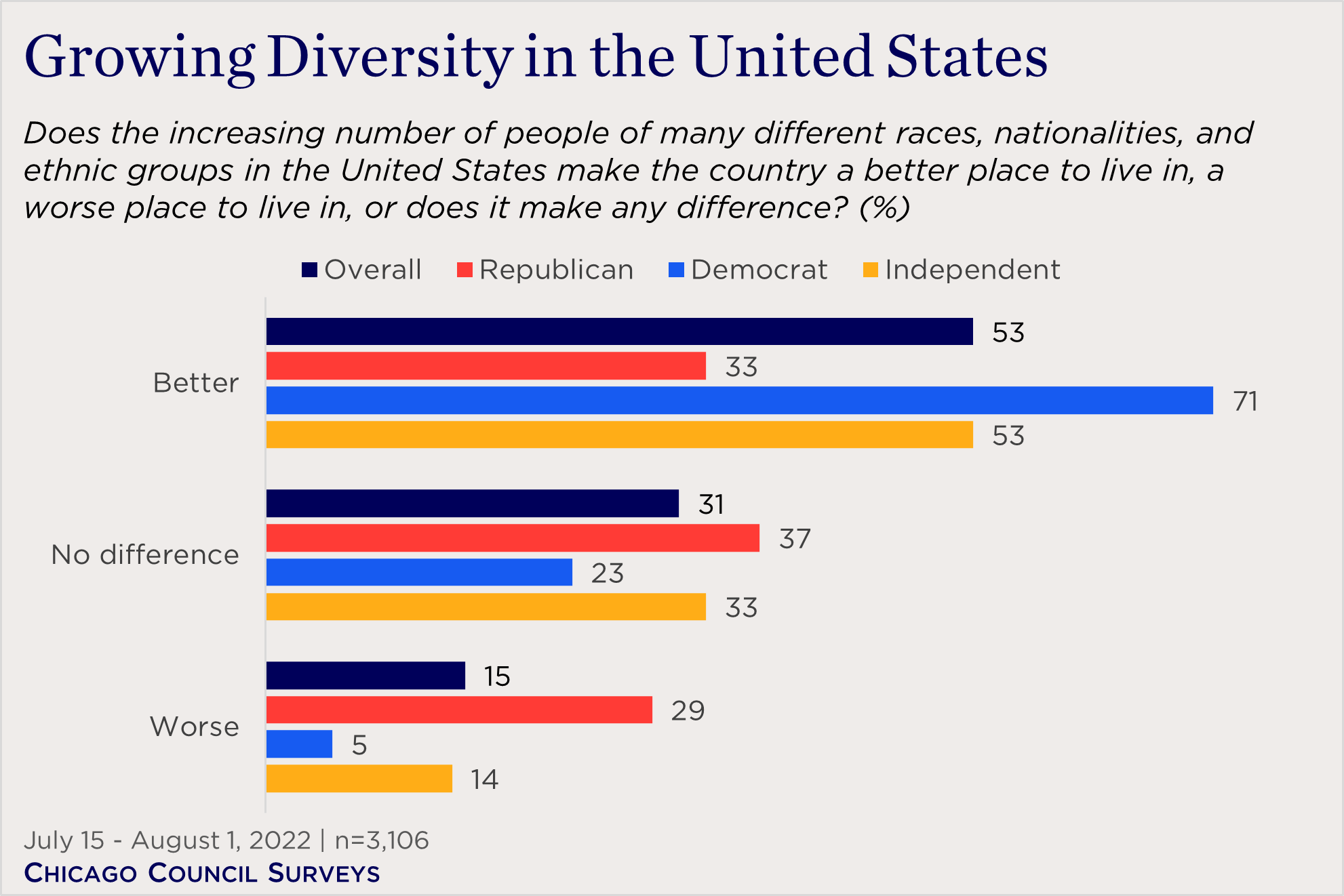
Republicans View Large-Scale Immigration as a Threat to the United States
The unease with which many Republicans view the increasing diversity of the United States is clearly reflected in Republicans’ views on immigration. Among the Republican public, 70 percent say a large number of immigrants and refugees coming into the United States represents a critical threat to the country. In the 2022 Chicago Council Survey, more Republicans name this a critical threat than any other issue asked about, including international terrorism and the nuclear programs of Iran and North Korea.
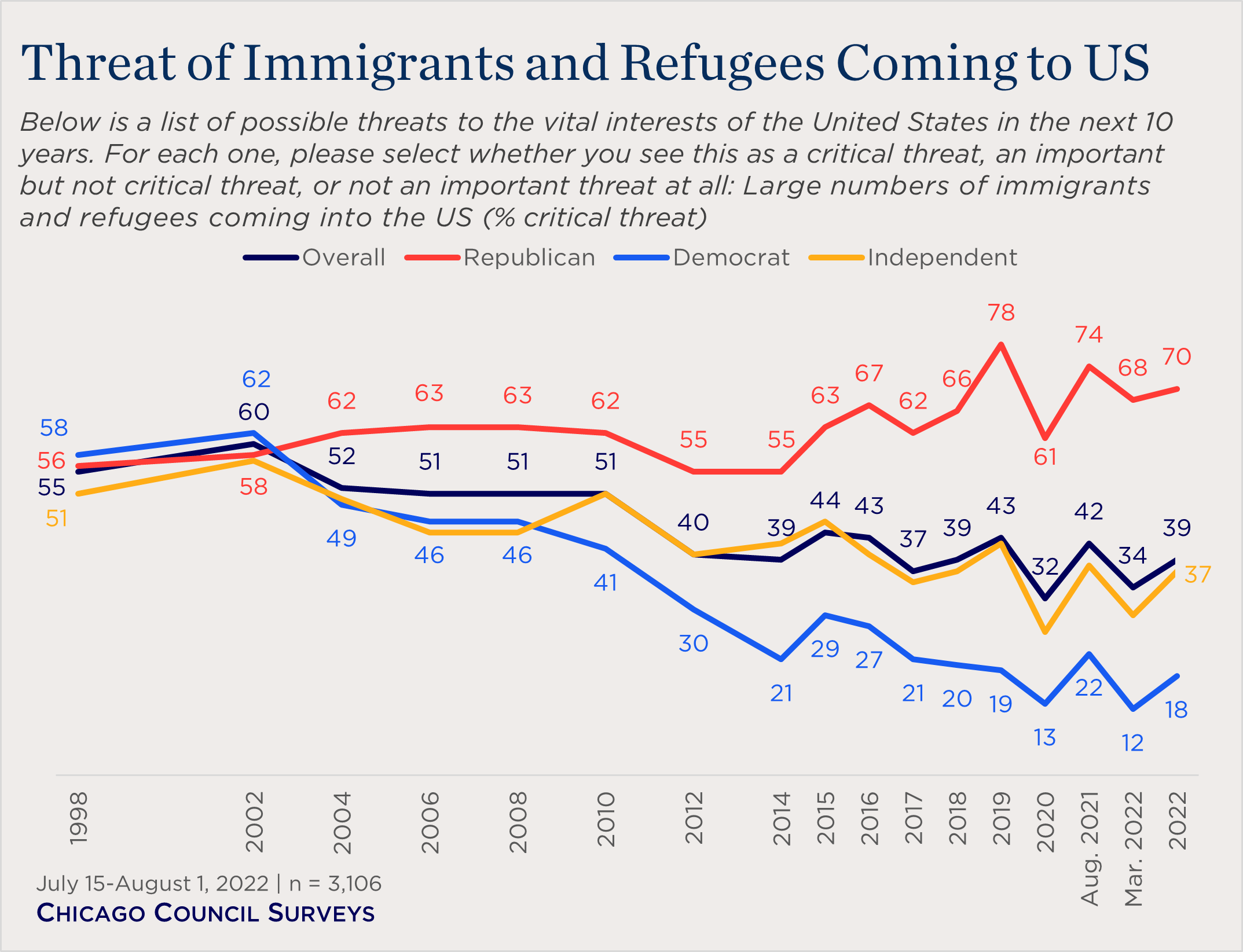
Over the past two decades, American concern over large numbers of immigrants and refugees coming into the US has steadily declined. This change has been driven primarily by a decline in concern about immigration among Democrats and Independents, while Republican concerns have remained fairly stable. Today, just 37 percent of Independents and 18 percent of Democrats view the prospect of large numbers of immigrants and refugees entering the US as a critical threat.
Rising Support for Legal Immigration—With Deep Partisan Divisions
At the same time that American fears of immigrants and refugees coming into the country have declined, the public has become more likely to support maintaining or increasing levels of legal immigration. Today, Americans are divided over the level of legal immigration that should be allowed into the United States. A plurality (43%) say that legal immigration should be kept at its present level, while 28 percent each favor increasing or decreasing legal immigration to the United States.
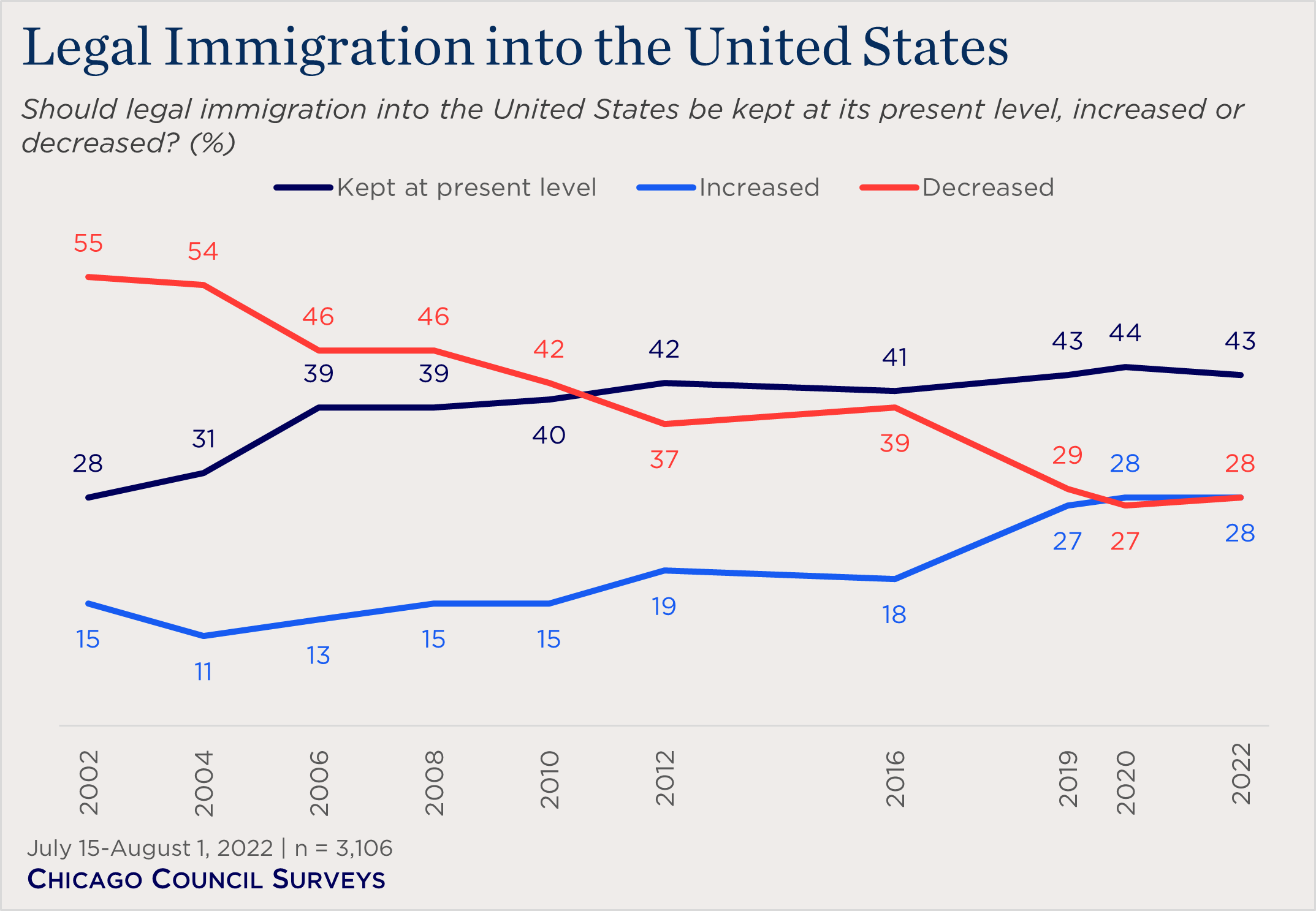
This shift in overall American opinion about the proper level of legal immigration has been driven primarily by changing views among Democrats.
In 2002, a majority of Democrats believed that legal immigration should be decreased (55%). Today, however, that view is far less popular among Democrats, only 15 percent of whom support decreasing legal immigration. This represents a decline of 40 percentage points from 2002. Over the same time span, the proportion of Democrats who favor increasing legal immigration has risen from 14 percent in 2002 to 39 percent today.
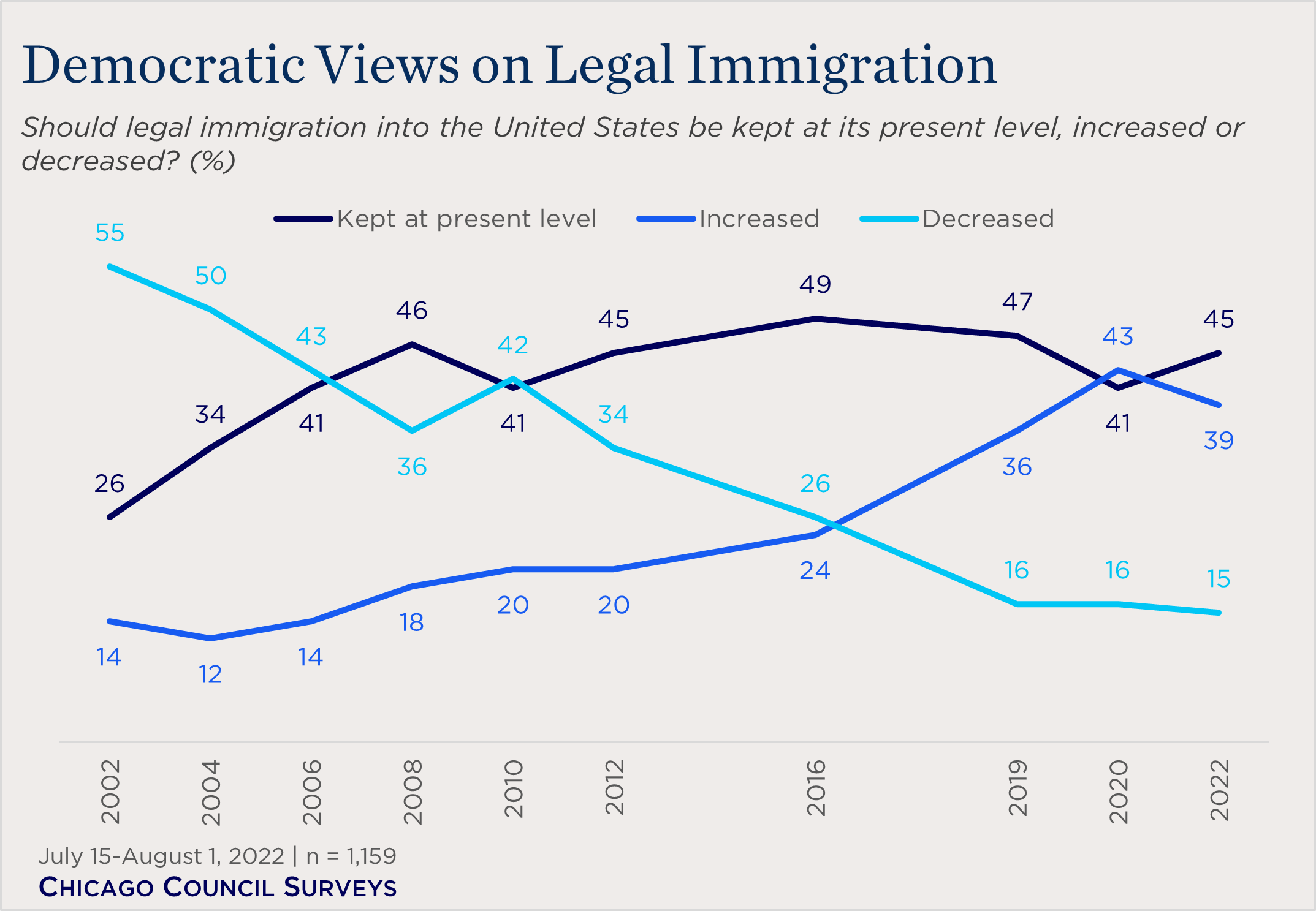
Republicans’ views on legal immigration have stayed relatively stable as Democrats’ views have changed over the last two decades, opening an increasingly large partisan gap on legal immigration levels. During this period, decreasing the level of legal immigration has become less popular among Republicans (-14 points), although it is still the option favored by the plurality. More Republicans today than 20 years ago favor maintaining current immigration levels (+13%), but the portion favoring increasing immigration remains almost exactly the same as it was in 2002 (+1%).
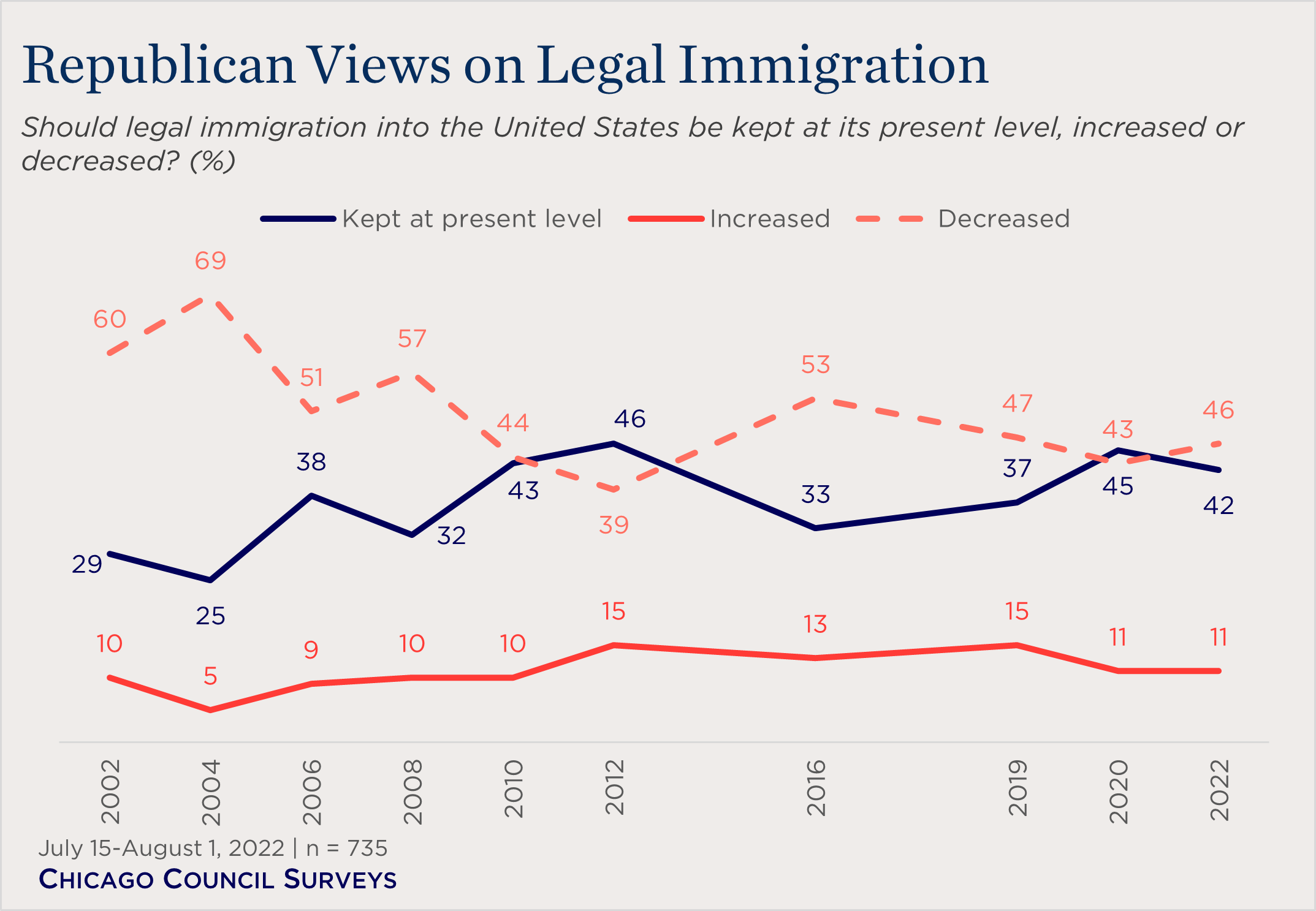
Immigration and Ideology: Trends Within the Parties
Divisions on immigration don’t just exist between the parties. There are also notable divisions within both the Republican and Democratic parties along ideological lines—but on different aspects of immigration.
Those Republicans who say their political ideology is conservative or extremely conservative are increasingly more likely to view large numbers of immigrants and refugees entering the country as a critical threat, compared to less concern among Republicans who identify as moderate.
For Democrats, the division comes on questions of legal immigration. Over the past two decades, Democrats of all ideological stripes have become less likely to support cuts to legal immigration. But while liberal and extremely liberal Democrats have become significantly more likely to favor increases to legal immigration, those Democrats who are slightly liberal or moderate have moved to favor maintaining current levels of immigration, rather than an increase or decrease.
Republican Divisions over the Threat of Immigration
The view that large numbers of immigrants and refugees entering the country is a critical threat has grown slightly among Republicans in recent years, driven primarily by growing concern among more conservative Republicans. 1 In 2014, similar proportions of conservative and more moderate Republicans viewed immigration as a critical threat, as did ideologically conservative independents.2 Over the past eight years, more conservative Republicans have become more likely to name migration as a critical threat, while views among more moderate Republicans and conservative Independents have remained stable. Today, eight in 10 conservative Republicans view the issue as a critical threat to the United States, compared to 59 percent of conservative Independents and 56 percent of more moderate Republicans.
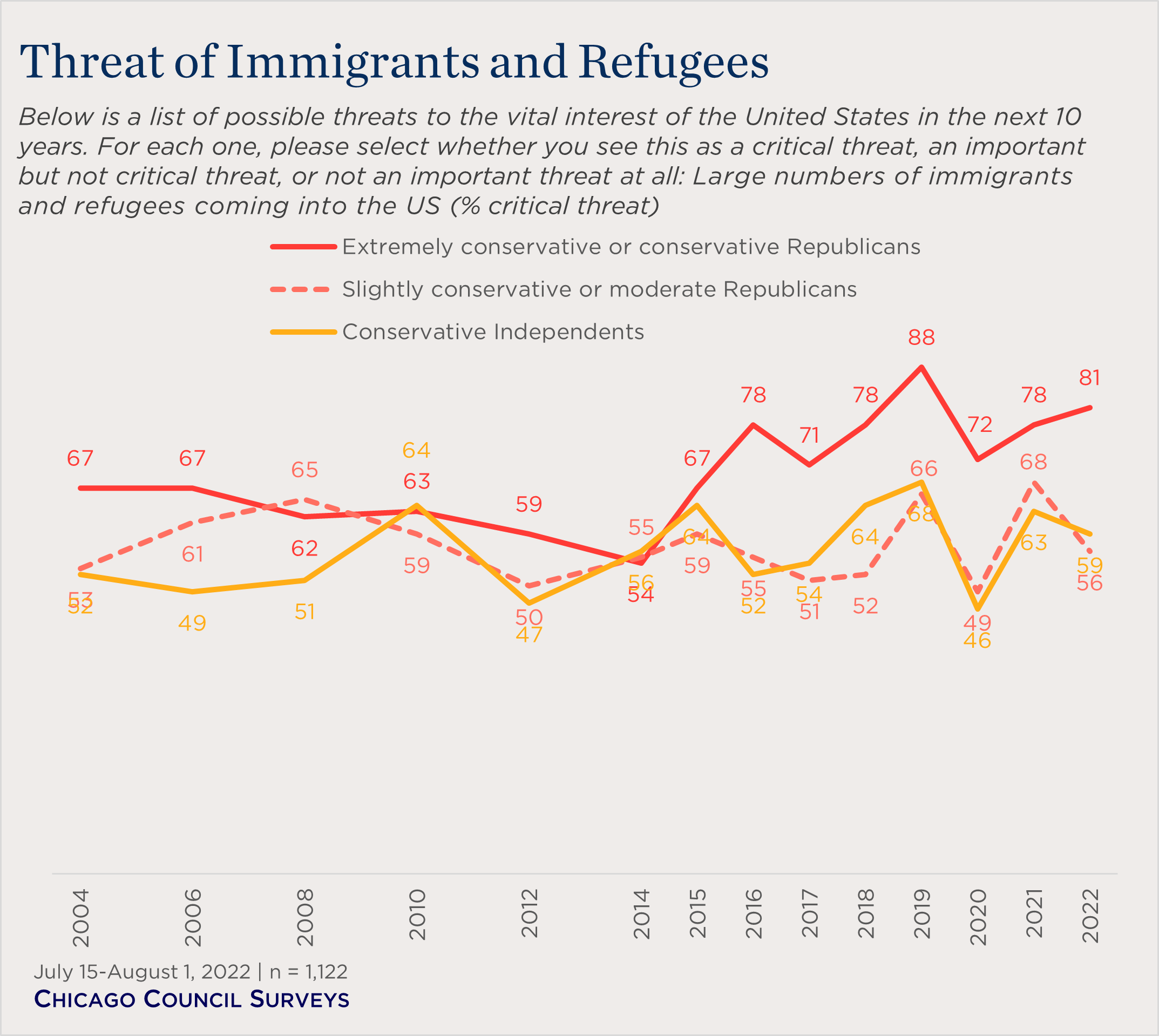
These ideologically conservative Republicans are also more likely to identify immigration as a critical threat to the United States than other foreign policy challenges. Large numbers of immigrants and refugees entering the country is viewed by more conservatives as a threat (81%) than issues such as a disruption in the energy supply (72%) or Iran’s nuclear program (69%).
For Republicans who say they are slightly conservative or moderate, immigration doesn’t come as high on the priority list. While a majority see it as a critical threat (56%), it’s surpassed by concerns about the energy supply (62%) and a global economic downturn (59%). This same basic pattern holds for independents who identify as ideologically conservative: while immigration is viewed as a critical threat by 59 percent of them, more are concerned about a disruption in the energy supply (64%), and they are similarly worried about China’s territorial ambitions (60%) or international terrorism (59%).
Democratic Divisions over Legal Immigration
Democrats, by contrast, are internally divided over legal immigration. In 2004, few Democrats of any ideological orientation favored increases to legal immigration.3 Over the past two decades, however, liberal Democrats and Independents alike have grown far more likely to support increased levels of legal immigration. Today, a majority of both groups (54% each) support increasing legal immigration. By contrast, those Democrats who are slightly liberal or moderate are less enthusiastic about increased legal immigration. While they have become more likely to support it than they were in the early 2000s, only three in 10 (30%) prefer increases to legal immigration; half (50%) prefer instead to maintain existing levels.
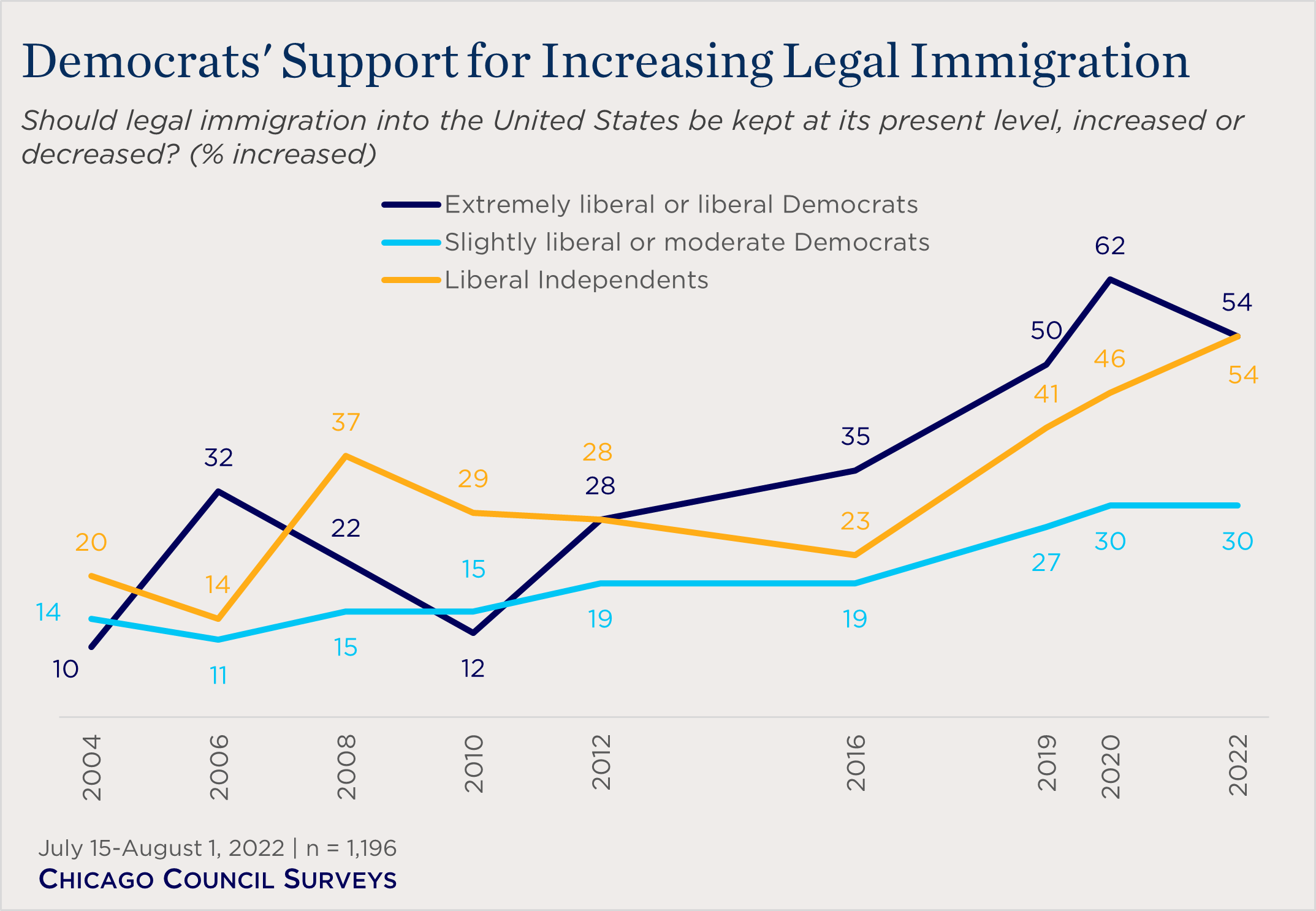
By contrast, Republicans have not seen a similar divergence along ideological lines on legal immigration issues. More conservative Republicans (50%) remain likely than moderates or conservative Independents (41% each) to favor cuts to legal immigration, as has been the case for the past two decades. Moreover, the gap between conservative and moderate Republicans has remained relatively consistent over those two decades, rather than expanding or contracting.
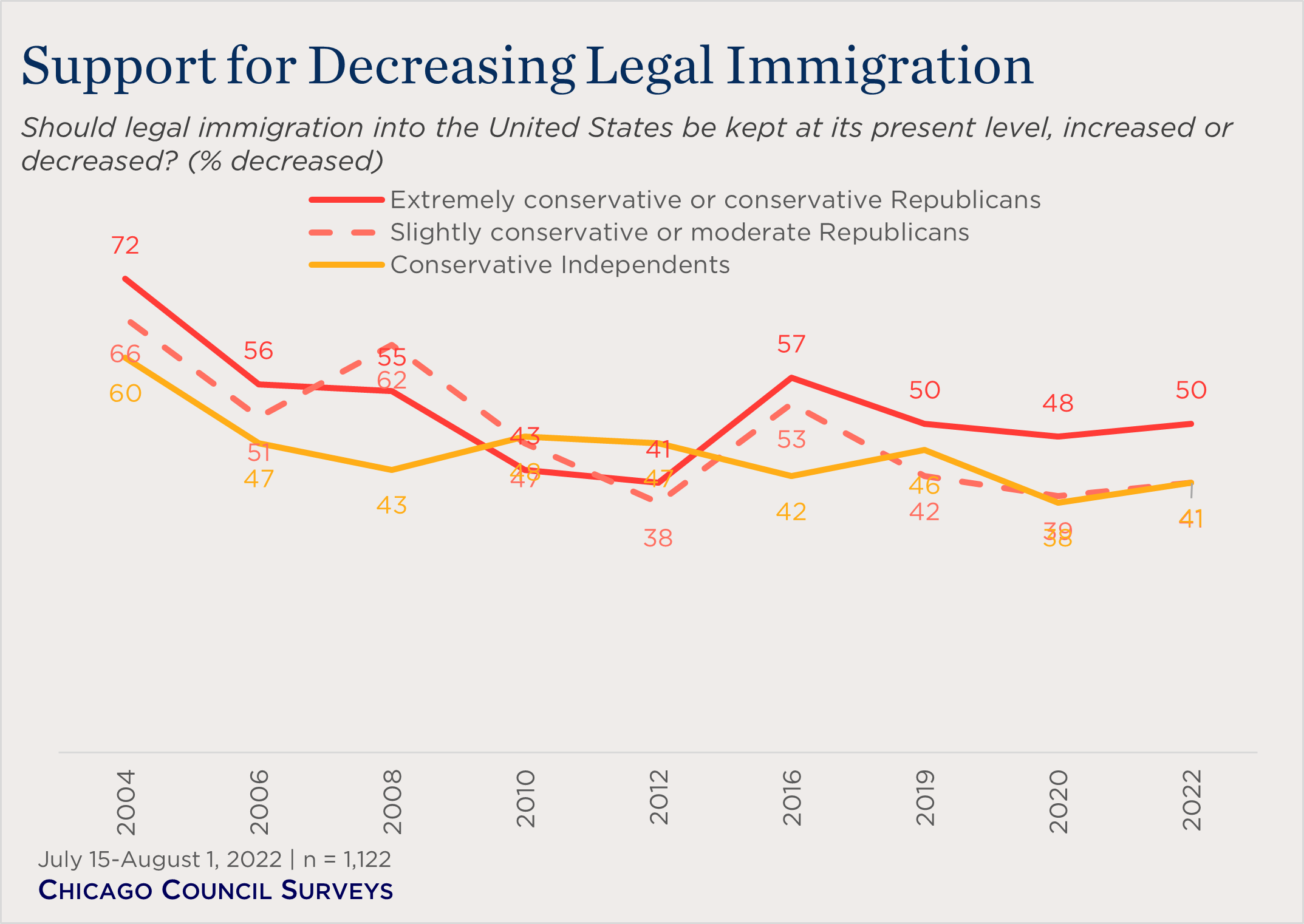
Links Between Views about Diversity and Immigration
A common thread running through both parties’ divisions on immigration are their underlying views about the effect of the growing diversity of the United States. As the 2022 Chicago Council Survey reveals, there are clear relationships between views about diversity in the United States and immigration. Americans who feel more negatively about the growing diversity of the country are far more likely to view immigrants and refugees coming into the country as a critical threat (77%), compared to those who see growing diversity making no difference to the country (50%) or making it better (22%).
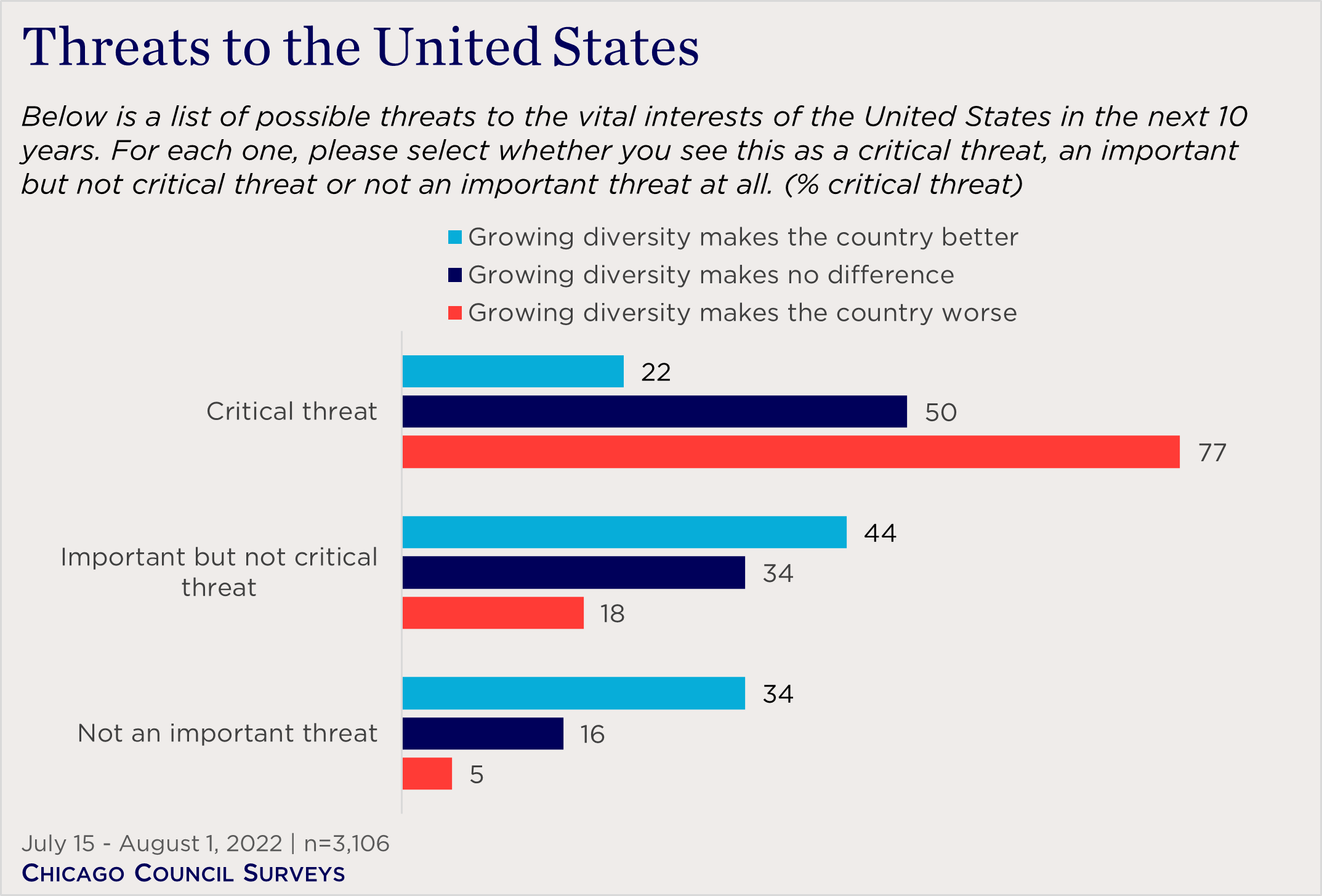
Similarly, those Americans who believe that growing diversity makes the country worse are also far more likely to favor cuts to legal immigration (61%), while those who say it makes the country better are more inclined to maintain (43%) or increase (42%) level of legal immigration.
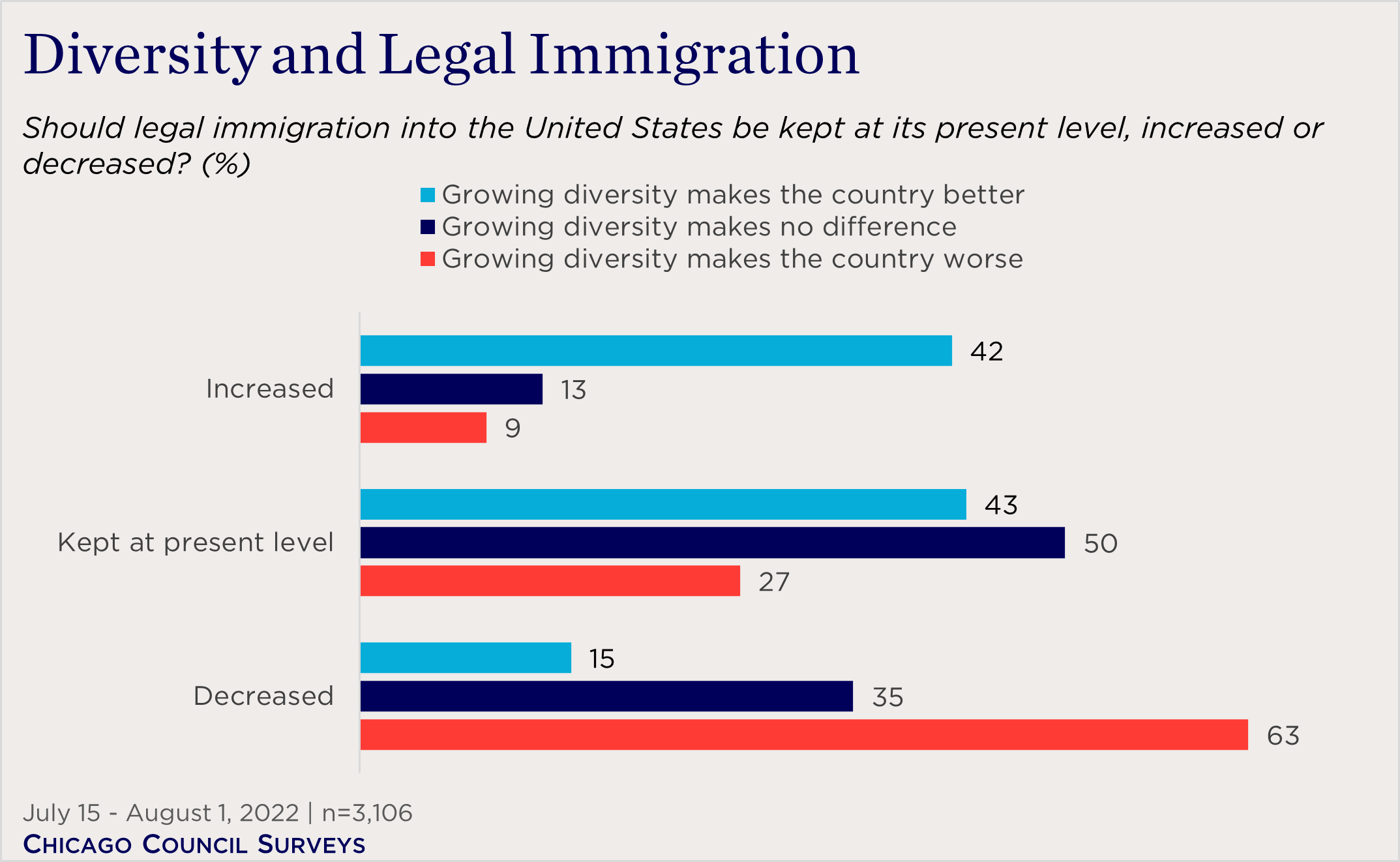
Most Americans Across Partisan and Ideological Lines See Diversity as Improving the US
While views of diversity and immigration are clearly related, the idea that growing diversity makes the country worse is a minority opinion among all partisan and ideological groups of Americans. Indeed, far more common is the view that growing diversity improves the country. That position is held by a majority or plurality of Democrats across the ideological spectrum, as well as liberal and moderate independents, and slightly conservative or moderate Republicans. Only conservative or extremely conservative Republicans are more likely to see growing diversity as making the country worse (33%) rather than better (24%)—and even for this group, the plurality position is that growing diversity makes no difference to the country.
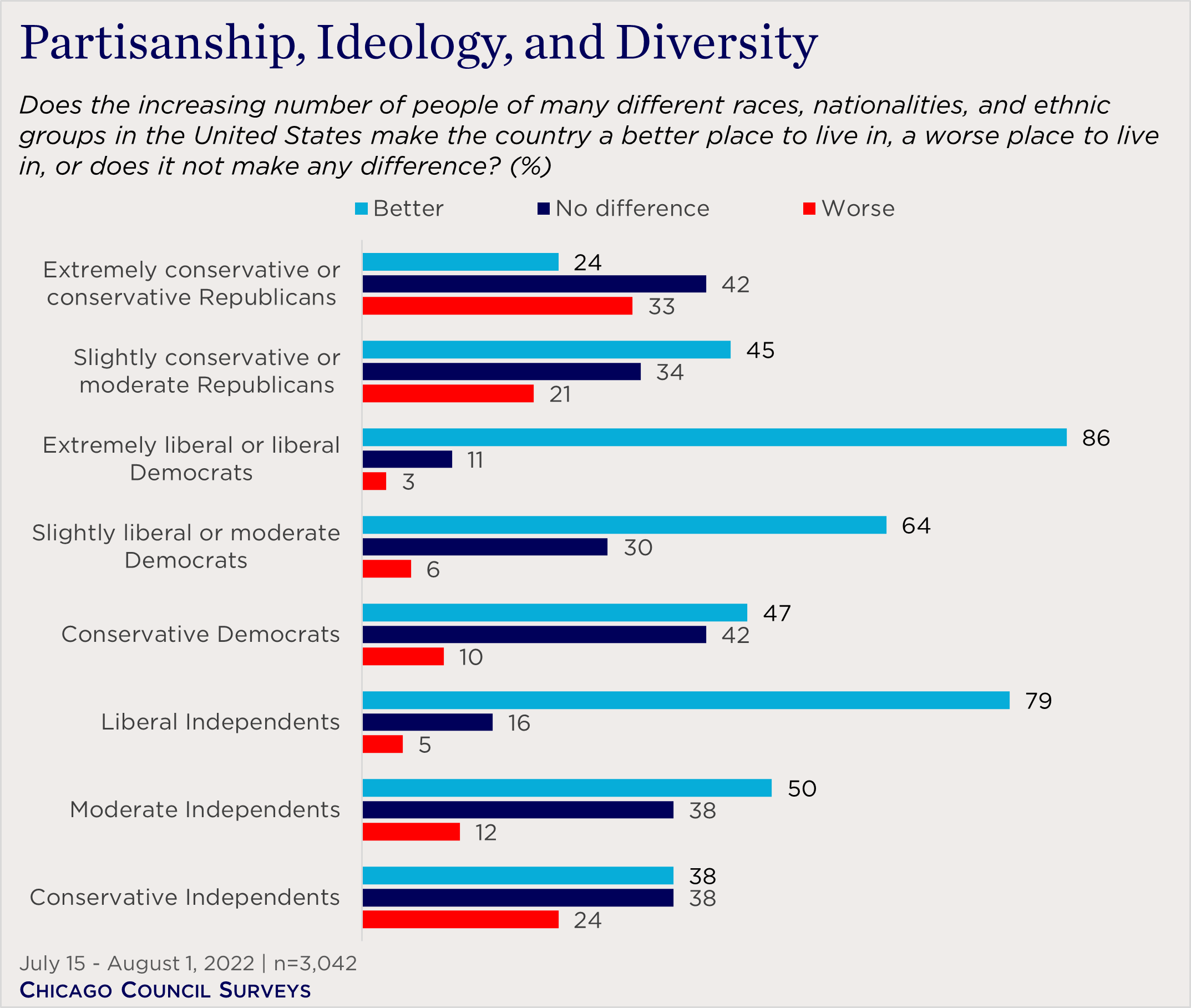
Conclusion
Immigration is never far from the political mainstage, and immigration rhetoric often reaches a fever pitch around elections—recall the focus on “migrant caravans” in 2018. This cycle, the efforts of Republican governors in Texas and Florida to send asylum-seekers from their states to cities like Chicago and Martha’s Vineyard represented a further escalation in the partisan conflicts around immigration policy. With the 2022 midterm elections now past and the 2024 presidential campaign about to begin in earnest, immigration once again looks to be a major issue confronting American political leaders in a narrowly-divided Congress.
However, as the Council’s data show, there is also plenty of conflict within the two parties’ bases over questions of immigration and refugee policy. The Republican Party’s intense focus on immigration as a threat to the country is matched by its more conservative adherents among the public, but not among more moderate Republicans, whose levels of concern remain largely unmoved over the past two decades. Similarly, while the Democratic Party’s policy platforms on immigration policy have moved steadily toward the left—matching the more liberal members of the public—not all Democrats have followed suit, with more moderate Democrats notably less enthusiastic about increased levels of legal immigration.
Among both partisan groups, attitudes towards immigrants and immigration policy are linked to their underlying views on a more diverse United States. Yet it is once again worth emphasizing that the view that increased diversity makes the country a worse place to live is a minority viewpoint among Republicans, Democrats, Independents, and every political and ideological subgroup thereof.
- 1Not included in this analysis are Republicans who identify as ideologically liberal. This is because they are a very small group: roughly one percent of Americans identify this way, which makes the group too small to report on.
- 2'Conservative Independents’ as a group include those who identify as extremely conservative, conservative, or slightly conservative.
- 3In most years of the Chicago Council Survey, there are not enough conservative Democrats to be confident in reporting specific results for their views on immigration. The available data suggests that they resemble slightly liberal or moderate Democrats on this question, and the larger sample of the 2022 Chicago Council Survey lends additional credence to this.




Appendix: Supplemental Figures/Tables
| Partisanship + Ideology | % of overall sample | Count (unweighted) |
|---|---|---|
| Conservative + extremely conservative Republicans | 16 | 491 |
| Slightly conservative or moderate Republicans | 10 | 301 |
| Liberal Republicans | 1 | 33 |
| Liberal + extremely liberal Democrats | 14 | 429 |
| Slightly liberal or moderate Democrats | 17 | 529 |
| Conservative Democrats | 3 | 93 |
| Liberal Independents | 8 | 238 |
| Moderate Independents | 20 | 605 |
| Conservative Independents | 11 | 330 |
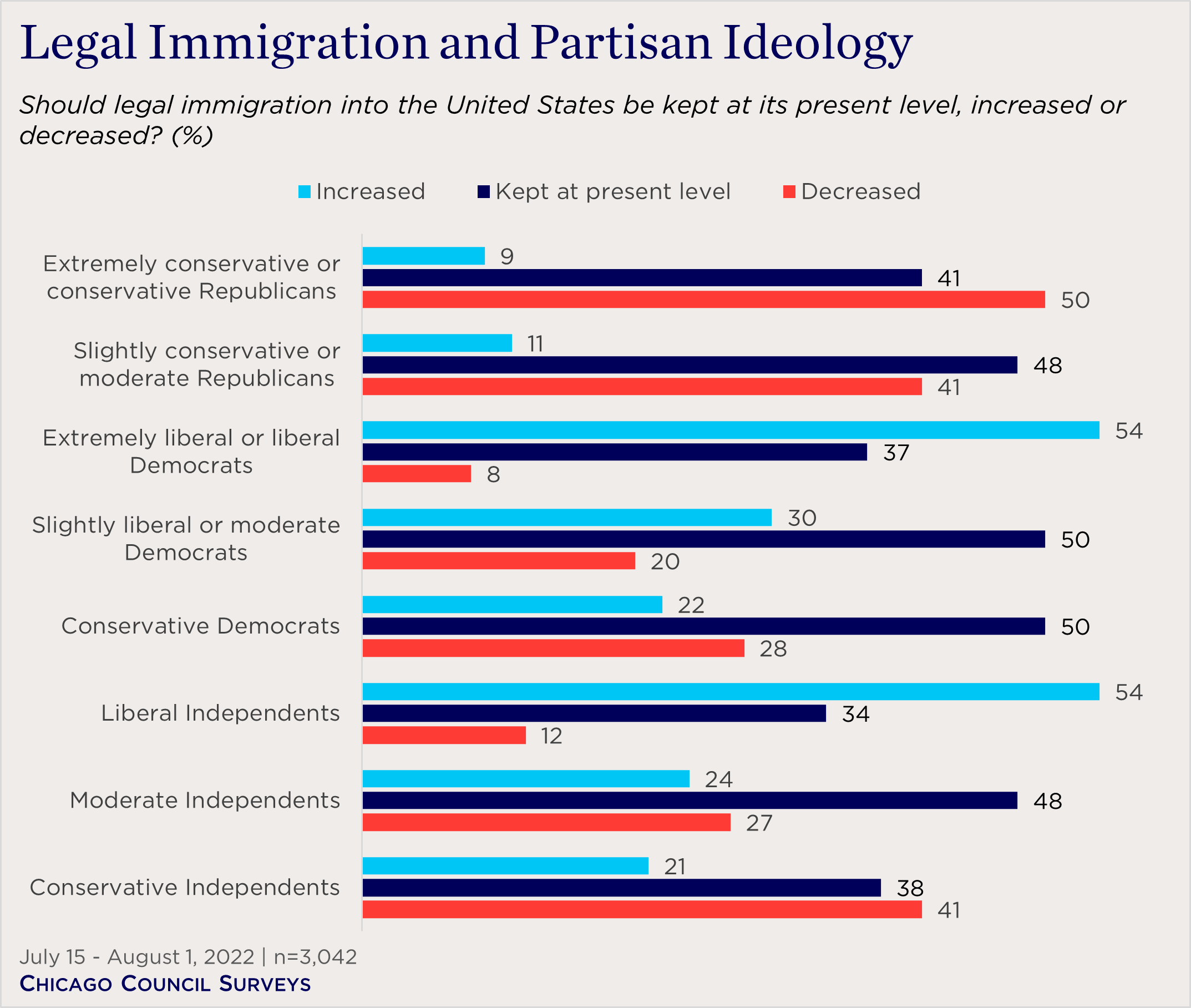
Methodology
This analysis is based on data from the 2022 Chicago Council Survey of the American public on foreign policy, a project of the Lester Crown Center on US Foreign Policy. The 2022 Chicago Council Survey was conducted July 15–August 1, 2022, by Ipsos using its large-scale nationwide online research panel, KnowledgePanel, in both English and Spanish among a weighted national sample of 3,106 adults 18 or older living in all 50 US states and the District of Columbia. The margin of sampling error for the full sample is +/- 1.8 percentage points. The margin of error is higher for partisan subgroups or for partial-sample items.
Partisan identification is based on how respondents answered a standard partisan self-identification question: “Generally speaking, do you think of yourself as a Republican, a Democrat, an Independent, or what?”
The 2022 Chicago Council Survey is made possible by the generous support of the Crown family and the Korea Foundation.

Related Content
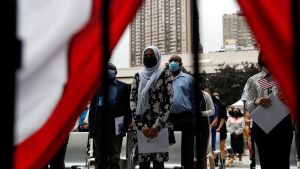 Migration
Migration
But American concern about large numbers of immigrants and refugees coming into the country has steadily decreased over the past decades.
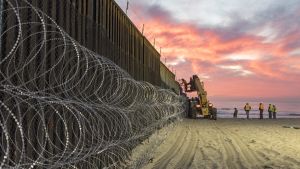 Public Opinion
Public Opinion
Despite majority approval among Democratic public, congressional Democrats struggle to pass immigration reform.
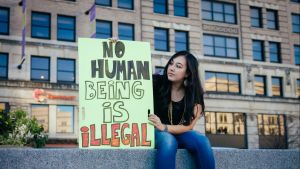 Migration
Migration
Chicago is positioned to elevate itself as a bold city, capable of taking on cutting-edge policies and providing accessible opportunities for all residents.
 Migration
Migration
Cities of the American Midwest were largely built by immigration, and immigrants were a key component of the population growth these cities experienced in the early decades of the last century.